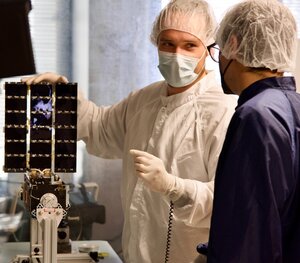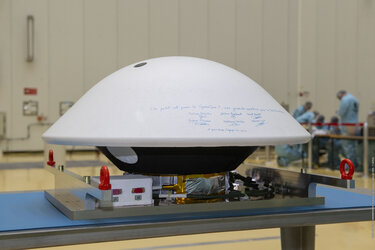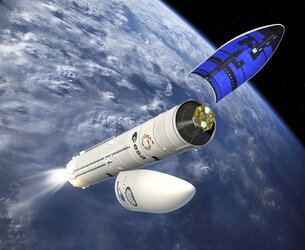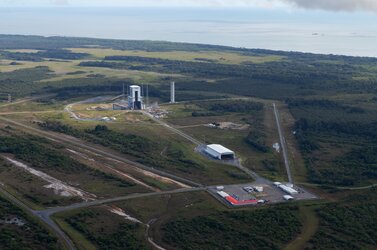Ariane 6 launches: YPSat-1 ‘the witness’
Europe’s newest rocket soon launches, taking with it many space missions each with a unique objective, destination and team at home, cheering them on. Whether launching new satellites to look back and study Earth, peer out to deep space or test important new technologies in orbit, Ariane 6’s first flight will showcase the versatility and flexibility of this impressive, heavy-lift launcher. Read on for all about YPSat-1, then see who else is flying first.

The Young Professionals Satellite (YPSat) will remain attached to the Ariane 6 upper stage, recording the historic flight from the moment the fairing separates and the other passengers first see the darkness of space, to the very end as the stage and satellite deorbit and burn up in Earth's atmosphere. Impressively, it has been entirely designed and built by ESA’s newest space recruits.
YPSat-1 is an initiative from ESA’s very own Young Professionals group who join the Agency in various positions from Graduate Trainees to Junior Professionals, Research Fellows, National Trainees and Student Interns, benefitting from tailored learning and development opportunities to prepare them for a position at ESA or elsewhere in the space sector.

The mission will capture phases of Ariane 6’s inaugural flight – from fairing separation to the deployment of each of its payloads, capturing also views of Earth and space from orbit. YPSat-1 will also offer a platform for ‘host payloads’ such as OscarQube, which will use innovative quantum-based sensors to measure the Earth's magnetic field along the launch trajectory, and AMSAT, an onboard antenna for ham radio communication.
As well as documenting the vital stages of launch and supporting other missions, YPSat-1 gives the team of about 45 entry-level professionals hands-on experience and a high level of responsibility in designing, building and testing space technology.
Two challenges will keep the YPSat-1 team particularly busy once the mission is launched: transmitting YPSat-1’s data while it remains attached to the Ariane 6 upper stage, and ensuring the spacecraft wakes up earlier than traditional missions do.

"This opportunity to be part of the Ariane 6 inaugural flight puts YPSat-1 at the forefront of a historic moment in European space exploration,” explains Tuur Strobbe, YPSat-1 Project Manager and Graduate Trainee at ESA’s ESTEC technical heart in the Netherlands.
“To make sure our spacecraft eyes are open on time, ready to record Ariane 6's two huge half fairings as they split and separate from the rocket, we've developed a custom autonomous 'Wake up System'. This system uses a variety of sensors to detect the liftoff of the launcher and determine where in the launch timeline we are at that moment, this way we can pinpoint the exact moment for the YPSat-1 mission to begin”.

During the launch, the YPSat-1 team will even be situated in a control room at ESA’s ESOC mission control centre from where they will receive telemetry from their mission.
Once in flight, the team will have to consider the rotation of the rocket as they work to transmit its data home. They will have just one orbit, one shot at successfully retrieving their data, with limited communication windows as the rocket slowly turns.

“I'm so proud of the many groups of young professionals who came together from across all ESA sites to make this possible,” says Lasse Fredagsvik, Leader of Young ESA and Graduate Trainee at ESTEC.
“To have the chance to fly our own mission, with the wise advice and support of the Agency’s knowledgeable workforce, is just a dream come true for us all.”
Ariane 6 is planned to launch in June-July 2024. It follows the hugely successful Ariane 5, Europe's principal rocket for more than a quarter century, flying 117 times between 1996 and 2023 from Europe's Spaceport in French Guiana.

The new heavy-lift rocket has been designed for all possible futures, and at its core is maximum versatility. Ariane 6 can put any satellite or payload into any orbital path. This is made possible with the new restartable Vinci engine that will power up the Ariane 6 upper stage again and again, stopping and starting to insert spacecraft into any orbit they need to be. The launcher stores enough fuel for a final burn, once its passengers are deployed, to deorbit and reenter safely back through Earth’s atmosphere. YPSat-1 will witness it all, recording this historic flight live from the front row.
“It feels unreal that YPSat-1 will soon be launched. It is the climax of months of continuous teamwork in an amazing group that I’m so happy I had the chance to be part of,” says Marilia Matos, Ground Station Coordinator for the mission based at ESA's Italy side, ESRIN.
“It is incredible what the dedication of Young Professionals can achieve! I'm so grateful to have the chance to see something I directly contributed to be launched into space. I cannot wait to see the videos that our payload will produce!”
Find out about all the missions that will be flown on Ariane 6’s first flight and get all the latest in the run up to launch on the Ariane 6 homepage and Space Transport on X.















 Germany
Germany
 Austria
Austria
 Belgium
Belgium
 Denmark
Denmark
 Spain
Spain
 Estonia
Estonia
 Finland
Finland
 France
France
 Greece
Greece
 Hungary
Hungary
 Ireland
Ireland
 Italy
Italy
 Luxembourg
Luxembourg
 Norway
Norway
 The Netherlands
The Netherlands
 Poland
Poland
 Portugal
Portugal
 Czechia
Czechia
 Romania
Romania
 United Kingdom
United Kingdom
 Slovenia
Slovenia
 Sweden
Sweden
 Switzerland
Switzerland

























































